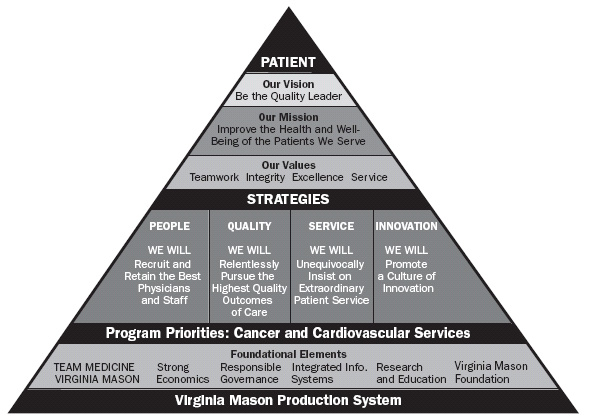This week in class we not only look at the Toyota Production System (TPS) at Toyota [1], we examine how lean manufacturing is being applied in non (traditional) manufacturing industries, such as health care [2] and in food service [3]. In particular, I was intrigued by how the Seattle Children's Hospital has applied lean manufacturing to reduce inventory, cut costs, and improve quality of care [1].
In response to the NYT article on Seattle Children's Hospital (SCH), I chose to look at lean manufacturing at another healthcare institution, the Virginia Mason Medical Center (VM). It appears as if VM has gone far beyond SCH in its scale and scope of lean process implementation. I am still left with two underlying questions, however. First, will suppliers in healthcare be willing to support hospitals such as VM in implementing lean processes? Second, is lean manufacturing good for employees of healthcare providers in the long run?
 Virginia Mason Medical Center
Virginia Mason Medical CenterIn 2002, VM implemented its own version of the Toyota Production System called the Virginia Mason Production System (VMPS). This system had six focus areas [4]:
1. “Patient first” driver for all processes.
2. Creating an environment in which employees feel safe creating efficiencies.
3. Instituting a Company wide alert system called “Patient Safety Alert System.”
4. Encouraging employees to innovate and “trystorm”
5. Improving the Company’s financial position by eliminating waste6. Maintaining accountable leadership (p. 12).
The purpose of this plan was to reduce costs by eliminate process waste. VM also partnered with the distributor Owens&Minor to transform its supply chain.
Like SCH, VM hoped that going to 'lean' processes would not just save costs but would also improve quality of treatment.
Using Employees
"The Evolution of Toyota," describes the lengths at which Toyota uses its employees to improve process efficiency. On average, each employee suggests 10 improvements per year and 99% of all suggests are implemented [2]. Like Toyota, VM understood that, in order to make a comprehensive improvement of inventory management, it would need the support of all employees [4].
VM instituted four policies which allowed it to gather and use process improvement suggests from its employees.
1) All new employees were groomed into the culture through an “Intro to Lean” course at the start of their employment (p. 4).
2) VM instituted a "no layoff" policy. Employees were encouraged to suggest improvements because, be contract, no process improvements would result in layoffs. Instead staffing adjustments were made exclusively through attrition and restructuring of departments (p. 3).
3) VM created a "Patient Safety Alert System" which employees could use to submit reports of problems or inefficiencies online. In that way, VM managers were presented with problems in real time and encouraged to investigate them as soon as possible (p. 12).
4) VM would engage its employees in Rapid Process Improvement Workshops (RPIW), to suggest and suggest solutions to larger problems in the process network (p. 4).
Results
Between 2002 and 2005, inventory at VM went down by $1,350,00 ( 53%), FTE’s went down 158 positions (36%), use of floor space decreased by 22,324 square feet (41%), lead time decreased by 23,082 cumulative hours (65%), people distanced traveled decreased by 267,793 miles (44%), product distance traveled decreased 272,262 miles (72%), and set up time decreased by 7,744 hours (82%) (p. 4).
VM also increased the capacity of its existing facilities by making them more efficient. As a result, VM delayed several capital expenditures, rescinding an order for a $1 million dollar hyperbolic chamber, delaying the relocation of 1 to 3 endoscopy suites, and halting construction on $6 million dollars worth of new surgery suites (p. 3).
Discussion/Questions
Just like SCH, VM's VMPS allowed it to reduce cost, improve quality of care, and limit FTEs. It should be noted, however, that VM would not have been able to reduce these cost had it not found a willing partner in OM. By agreeing to a Total Supply Chain Costs Contract (TSCC), OM provided VM the flexibility to seek out its own process inefficiencies. For other health care providers I am curious, are there other suppliers who are willing to take a similar risk and partner for 'lean' goals?
Lastly, using the VMPS, VM was able to reduce its FTEs by 158 positions over the first 3 years of the program (p. 4). Although this paper did not discuss labor unrest, nurses did strike at SCH over the lower staff levels of its 'lean' operations [1]. If more healthcare providers adopt lean processes, a larger quantity of healthcare employees (likely nurses and janitorial and support staff) will be out of work. Will this impending reduction in labor stop the spread of lean processes in U.S. healthcare through union unrest? If not, is the healthcare industry setting itself up for disaster if, due to an unforeseen disaster, large quantities of support staff are suddenly needed again?
Sources:
[1] Weed, Julie. "Factory Efficiency Comes to the Hospital." The New York Times, July 9, 2012.
[2] Hansa, L. "The Evolution of the Toyota Production System." IBS Case Development Centre, No. 604-032-1, 2004.
[3] Jargon, Julie. "Latest Starbucks Buzzword: 'Lean' Japanese Techniques." The Wall Street Journal, August 4, 2009.
[4] “Going Lean in Healthcare.” Institute for Healthcare Improvement, 2005. Internet; Available from http://www.entnet.org/Practice/upload/GoingLeaninHealthCareWhitePaper.pdf

Hey...
ReplyDeleteThis is a great web site of Lean Manufacturing. Nice informative articles but not more. I will be coming back in a bit,
Thanks for the great article!!
Tiejun Tang Silent myocardial ischemia (SMI), also called
ReplyDeleteasymptomatic
myocardial ischemia, is the most common manifestation of
coronary heart disease. SMI patients
do not seek medical attention as often as angina pectoris
patients because SMI
does not nece...
TOSHIBA PLQ-703A